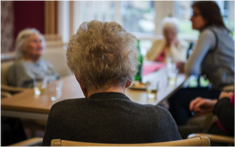 It's Mental Health Awareness Week 21 September – 27 September. Mental Health Awareness Week is run each year by the Mental Health Foundation and it's more timely than ever. This year's theme is Reimagine Wellbeing Together – He Tirohanga Anamata. It’s time to reflect on how we can all improve our mental health. The five ways to wellbeing guide Five Ways to Wellbeing is a set of five simple, evidence-based actions which can improve wellbeing in everyday life. Background The Five Ways to Wellbeing was introduced to Aotearoa New Zealand in 2009 as part of Mental Health Awareness Week, building on work done by the New Economics Foundation (NEF) for the UK Government. This paper aims to develop confidence in organisations and workers that their communication of the messages is supported by best practice, built upon good understanding of the evidence and reflects a consistent national approach. The Mental Health Foundation has commissioned a review of how the Five Ways to Wellbeing has been implemented in Aotearoa since 2009. Further information and practical tips on how to use the Five Ways is available on the website. Wellbeing The Mental Health Foundation believes one of the key aims of a democratic government is to promote the good life: a flourishing society where citizens are happy, healthy, capable and engaged. In other words, a society where people have high levels of wellbeing. Recent years have seen a shift away from a focus on illness alone, to more attention on wellness, both in policy and health practice. In a New Zealand context, this has included better integration of Maori and Pacific concepts of health, including holistic models such as Te Whare Tapa Wha and Fonofale. Illness and wellness are now considered to be more than simply two ends of a continuum, but separately operating dimensions. Five ways to wellbeing: For more information: www.mentalhealth.org.nz
Prevent the spread of cold and flu with regular hand washing In the mid 19th Century Ignaz Semmelweis and Florence Nightingale pioneered hand washing as prevention against the spread of infection. This simple practice revolutionised health care and public health. It is still as important today as it was then. Hand washing is the most effective means of preventing the spread of infection, including winter colds, and flu. Hand washing needs to be done before:
and after:
Hand washing is not just putting a little soap on your hands and running them under the tap. It requires soap that froths, cleaning all the surfaces of the hands for at least 20 seconds. The following 7 steps for good hand washing are: Step 1: Turn on taps; adjust water temperature to desired heat. Step 2: Wet hands under running water. Step 3: Apply soap to palm of hand (use a soap that froths up well) Step 4: Ensure contact of soap with all surfaces for at least 20 seconds, refer to the following: a) Palm to palm b) Right palm over left back c) Palm to palm fingers of hand and vice versa interlaced. d) Backs of fingers to e) Rotational rubbing of f) Rotational rubbing, backwards and opposing palms with right thumb clasped forwards with clasped fingers of right fingers interlocked. in left palm and vice hand in left palm and vice versa. versa. Step 5: Rinse hands thoroughly for about 20 seconds, as long as it takes to sing Happy
Birthday through twice. Step 6: Dry hands thoroughly with clean towel or paper towel. Step 7: Where possible turn taps off with elbows or paper towel (avoid hand contact with taps and door handles). NB Any broken skin areas should be covered with a dressing. Hand washing technique (Aycliffe et al, 1978, Lawrence 1985) “The Origins of You: how childhood shapes later life”
New book examines how childhood shapes later life. Jim Mora’s interview of Richie Poulson, one of the researchers of the longitudinal Dunedin study on human development and author of: The origins of you: How childhood shapes later life. To listen to interview click here It is very interesting and we recommend you listen to it  Are you losing your mobility? As we age most of us want to keep our independence, this requires us to be mobile. The ability to get up and about with ease is essential for everyday life. How might you know if you are in danger of losing your mobility? To help, here are some early signs of immobility. They include:
There are many reasons why immobility may happen as we age, some common ones are:
The good news is in most cases we can improve our mobility by dealing with the underlying problem and doing regular strength and balance exercises. The sooner we start the better off we will be. Regardless of our age, regular exercise keeps us fit and makes us feel better. Being physically active strengthens the heart and lungs while supplying increased oxygen to the body. This nourishes and strengthens muscles and joints making them work more efficiently. The spin-off is you have greater mobility, feel more energetic, look better and possibly have more fun. If you or someone you know is showing signs of immobility our friendly Physiotherapists can help just contact us at Therapy Professionals. Ph: 03 377 5280 Email: [email protected] |
AuthorShonagh O'Hagan Archives
July 2024
|




 RSS Feed
RSS Feed